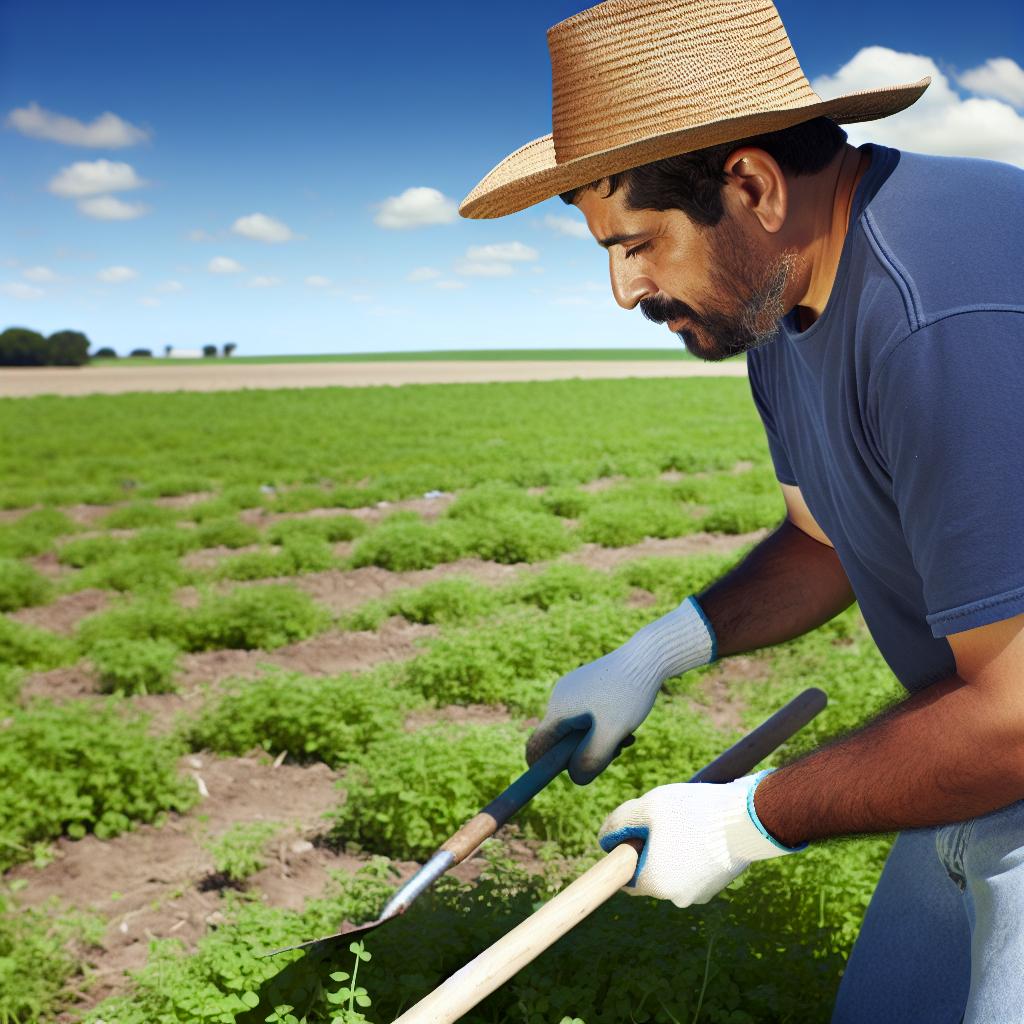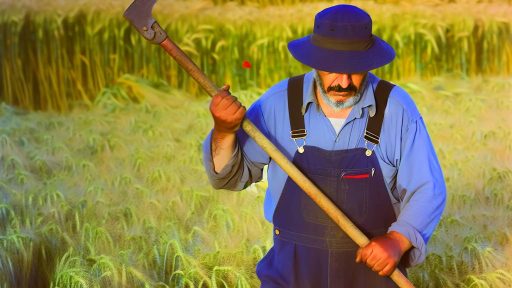Introduction to Long-Term Weed Prevention
Weed management is crucial for large landowners.
It directly affects crop yield and soil health.
Adopting effective weed prevention techniques ensures sustainable farming practices.
With the right strategies, landowners can minimize competition from unwanted plants.
This, in turn, promotes healthy ecosystems.
Moreover, long-term weed prevention saves on costly herbicides.
Effective prevention methods lead to less environmental impact.
Understanding the Importance
For large-scale agriculture, every weed counts.
Weeds can quickly multiply and spread across fields.
They absorb vital nutrients and water that crops need.
Consequently, farmers face reduced profits and increased labor costs.
Additionally, some weeds harbor pests and diseases.
This exacerbates already challenging agricultural conditions.
The Role of Sustainable Practices
Incorporating sustainable practices enhances weed management.
These practices focus on long-term solutions rather than quick fixes.
Transform Your Agribusiness
Unlock your farm's potential with expert advice tailored to your needs. Get actionable steps that drive real results.
Get StartedCrop rotation is one effective sustainable technique.
This method disrupts the life cycle of weed species.
Another practice is the use of cover crops.
Cover crops can suppress weeds and improve soil structure.
Benefits of Effective Weed Prevention
Proactive weed management supports overall farm productivity.
Landowners can expect healthier crops and better yields.
Furthermore, successful weed prevention reduces reliance on chemical herbicides.
This transition improves environmental health and farmer safety.
Ultimately, the goal is to create a balanced agricultural ecosystem.
Understanding the Lifecycle of Common Weeds: Key Insights for Effective Management
Overview of Weed Lifecycles
Weeds go through specific stages during their growth and development.
Understanding these stages helps in developing effective strategies for control.
Weeds typically include annuals, perennials, and biennials.
Annual Weeds
Annual weeds complete their lifecycle in one growing season.
These weeds germinate, grow, reproduce, and die within a year.
Examples include crabgrass and foxtail.
Controlling these weeds early is crucial to prevent seed production.
Perennial Weeds
Perennial weeds live for multiple years, often regrowing from their root systems.
Common examples are dandelions and bindweed.
Effective management requires targeting both foliage and root systems.
After a hard frost, perennials may become dormant but will resprout in spring.
Biennial Weeds
Biennial weeds take two years to complete their lifecycle.
During the first year, they primarily produce leaves and roots.
In the second year, they flower and produce seeds.
Examples include thistles that establish during the first year.
Showcase Your Farming Business
Publish your professional farming services profile on our blog for a one-time fee of $200 and reach a dedicated audience of farmers and agribusiness owners.
Publish Your ProfileSeed Germination and Growth Stages
Weed seeds require specific conditions to germinate effectively.
Moisture, temperature, and light influence seed germination.
After germination, seedlings start to grow rapidly in optimal conditions.
Controlling the weed population at these early stages is essential.
Reproductive Strategies
Weeds have diverse reproductive strategies that aid survival.
Some produce thousands of seeds; others spread through root fragments.
Understanding these strategies helps in choosing effective management techniques.
Experimenting with various control methods can yield successful results.
Cultural Practices for Weed Control
Crop Rotation
Crop rotation involves changing the type of crop grown in a specific area over time.
This practice disrupts the life cycles of weeds and can improve soil health.
By alternating crops, landowners can reduce weed seed banks and nutrient depletion.
For instance, rotating between legumes and cereals can enhance soil fertility.
Moreover, different crops have varying growth patterns that can suppress weeds effectively.
Implementing a variety of crops is essential for maintaining a balanced ecosystem.
Cover Cropping Techniques
Cover cropping provides protective ground cover during off-seasons.
This technique minimizes soil erosion and enhances soil structure.
Additionally, cover crops can suppress weed growth by outcompeting them for resources.
For instance, rye and clover are great options that help prevent weed establishment.
They also contribute organic matter to the soil when tilled under.
Ultimately, cover crops promote sustainability in farming practices.
Benefits of Combining Practices
Combining crop rotation with cover cropping leads to superior weed management.
This integrated approach maximizes land productivity while minimizing weed pressure.
Landowners can significantly reduce their dependence on chemical herbicides.
Moreover, this strategy enhances biodiversity within the agricultural ecosystem.
Healthy soil provides resilience against pests and diseases, reducing long-term costs.
Learn More: Satellite Imagery Analysis For Sustainable Farmland Purchase Decisions
Soil Management and Health
The Role of Soil Fertility in Weed Suppression
Ssoil fertility plays a crucial role in weed management.
Healthy soil supports robust plant growth and competition.
This competition minimizes space and resources for weeds.
Moreover, maintaining soil health enhances nutrient availability.
Nutrients like nitrogen and phosphorus are vital for crops.
Improved nutrient levels can weaken weed proliferation.
Organic matter enriches soil and improves structure.
Soil with high organic content retains moisture better.
Consequently, well-watered plants are more competitive against weeds.
Utilizing cover crops can help improve soil fertility.
These crops protect soil and suppress weed seeds.
Incorporating a diverse mix of crops aids soil health.
Diversity promotes beneficial microbial activity in the soil.
Additionally, crop rotation disrupts weed life cycles.
Showcase Your Farming Business
Publish your professional farming services profile on our blog for a one-time fee of $200 and reach a dedicated audience of farmers and agribusiness owners.
Publish Your ProfileThis reduces their ability to establish and thrive.
Also, regular soil testing is essential.
It helps landowners identify nutrient deficiencies.
Addressing these deficiencies enhances crop yield.
Moreover, improved yields can lead to reduced weed pressure.
Utilizing mulches can also be beneficial for suppression.
Mulch blocks light and hinders weed seed germination.
Finally, integrating proper irrigation practices is vital.
Consistent watering can support healthy plant growth.
This reduces the chances of weed establishment in the first place.
Delve into the Subject: Organic Weed Control Solutions for Sustainable Farming
Mulching Strategies
Benefits of Organic Mulches
Organic mulches consist of natural materials like leaves, straw, or wood chips.
They improve soil structure by adding organic matter as they decompose.
Additionally, organic mulches retain moisture effectively, reducing irrigation needs.
They suppress weed growth by blocking sunlight from reaching weed seeds.
Moreover, organic mulches attract beneficial organisms like earthworms and microbes.
These organisms contribute to healthier soil and increased nutrient availability.
Using organic mulches can enhance the aesthetic appeal of the landscape.
Benefits of Inorganic Mulches
Inorganic mulches include materials like gravel, stones, or black plastic.
They provide longer-lasting ground cover compared to organic alternatives.
Additionally, inorganic mulches effectively suppress weeds through light blockage.
They also create a barrier that regulates soil temperature effectively.
In places with heavy rainfall, inorganic mulches prevent soil erosion efficiently.
While they do not improve soil fertility, they require less maintenance over time.
Choosing the Right Mulch
Selecting the right mulch depends on your specific landowner needs.
Consider factors such as plant type, climate, and soil condition.
Using a combination of organic and inorganic mulches often yields the best results.
For instance, layering organic mulches over a fabric barrier can maximize benefits.
Furthermore, always ensure mulch is applied at the appropriate thickness.
Maintenance Tips for Mulched Areas
Regularly check mulched areas for weed growth throughout the season.
If weeds appear, promptly remove them to prevent competition for resources.
Additionally, replenish organic mulches as they decompose over time.
Inorganic materials may require occasional cleaning to maintain appearance.
Regularly assess moisture levels under mulch to avoid water stress on plants.
Finally, keep mulch away from plant stems to discourage rot and pest issues.
Explore Further: Using Integrated Pest Management for Organic Garden Protection
Integrated Pest Management (IPM)
Combining Biological, Cultural, and Mechanical Approaches
Integrated Pest Management (IPM) employs a holistic approach to weed control.
This method amalgamates biological, cultural, and mechanical strategies.
First, consider the biological methods available.
These methods often utilize natural predators to combat weeds.
Showcase Your Farming Business
Publish your professional farming services profile on our blog for a one-time fee of $200 and reach a dedicated audience of farmers and agribusiness owners.
Publish Your ProfileFor instance, certain insects target specific weed species.
Additionally, introducing competitive plant species can curb weed growth.
These plants occupy space and resources that weeds would otherwise exploit.
Next, implement cultural practices beneficial for weed management.
Crop rotation effectively disrupts the life cycle of persistent weeds.
This technique promotes biodiversity and enhances soil health.
Moreover, maintaining healthy soil is crucial.
Soil amendments improve crop vigor and outcompete weeds.
Now, let’s explore mechanical approaches in weed management.
Tillage remains a primary method for managing weed populations.
This practice disrupts the soil and uproots weeds when performed properly.
Furthermore, mulching can suppress weed growth effectively.
Using organic or synthetic materials denies light to unwanted plants.
Incorporating these varied strategies creates a robust IPM program.
Such programs lead to environmentally sustainable weed management.
Ultimately, IPM promotes healthier ecosystems and agricultural productivity.
Uncover the Details: Preventing Soil-Borne Pathogens For Long-Term Farmland Property Value ROI

Utilizing Technology
Tools for Monitoring Weeds
Technology offers innovative solutions for monitoring weeds effectively.
Remote sensing tools help landowners analyze large areas swiftly.
Satellite imagery provides insights into plant health and weed distribution.
Drones can capture high-resolution images for detailed assessments.
These tools enable proactive decision-making regarding weed management.
Innovations in Weed Control
Advancements in herbicide application technology improve precision.
Automated sprayers apply chemicals directly to target areas.
This efficiency minimizes herbicide use and environmental impact.
Robotic weeders are emerging as effective alternatives for manual labor.
They can differentiate between crops and weeds, enhancing productivity.
Data Management Solutions
Data analytics programs streamline weed management processes.
Landowners can track weed growth patterns over time.
This data informs long-term strategies and interventions.
Mobile apps allow real-time reporting and monitoring of weed issues.
Stakeholders can share information quickly and collaboratively.
Integration of Technology and Practices
Combining technology with best management practices yields optimal results.
Farmers should integrate soil testing and analysis with monitoring tools.
This approach ensures a comprehensive understanding of land conditions.
Regularly updating weed prevention strategies based on data is essential.
Ultimately, smart technology adoption fosters long-term sustainability.
Case Studies: Successful Long-Term Weed Prevention Practices by Large Landowners
The Green Valley Cooperative
The Green Valley Cooperative implemented diverse crop rotations.
This strategy disrupted weed growth cycles effectively.
After three years, they noticed a significant reduction in weed populations.
Showcase Your Farming Business
Publish your professional farming services profile on our blog for a one-time fee of $200 and reach a dedicated audience of farmers and agribusiness owners.
Publish Your ProfileAdditionally, they utilized cover crops in winter months.
These cover crops improved soil health while suppressing weeds.
The local agricultural extension office reported their success.
Farmers in the region adopted similar practices.
Pine Ridge Farms
Pine Ridge Farms focused on integrated pest management.
They introduced beneficial insects to control weed seeds.
This reduced the reliance on chemical herbicides over time.
Consequently, their yields improved, showcasing resilience.
The techniques employed showcased effective ecological methods.
For this reason, neighboring farms started implementing similar practices.
Riverbend Ranch
Riverbend Ranch adopted mulching techniques for weed control.
They applied organic mulch around crop beds each spring.
This practice not only suppressed weeds but enriched the soil.
Over five years, they witnessed improvements in soil moisture retention.
Furthermore, the ranch reported healthier crop yields annually.
Periodically, they shared their techniques at local workshops.
Windy Meadows Estate
Windy Meadows Estate embraced organic herbicide solutions.
The owners experimented with vinegar-based mixtures on stubborn weeds.
After testing various formulas, they found effective concentrations.
They documented the results and shared them online.
Farmers from different regions reached out for guidance.
Their innovative approach gained unexpected recognition.
Oak Hill Community Farm
Oak Hill Community Farm established a local weed management club.
This initiative encouraged peer-to-peer learning among farmers.
They held monthly meetings, discussing challenges and solutions.
The collaborative spirit fostered creative problem-solving.
Members reported noticeable improvements in their weed management practices.
Furthermore, they strengthened community ties through shared efforts.
Developing a Sustainable Weed Management Plan for the Future
Identifying Key Objectives
Begin by defining clear objectives for your weed management strategy.
Focus on reducing weed competition in your fields.
Prioritize enhancing crop yield and quality.
Consider the ecological impact of your management techniques.
Understanding Your Land
Conduct a thorough assessment of your land’s conditions.
Identify the types of weeds prevalent in your area.
Analyze soil composition and its effects on weed growth.
Review your land’s history to anticipate future challenges.
Integrating Cultural Practices
Implement crop rotation to disrupt weed life cycles.
Use cover crops to outcompete weeds for resources.
Tailor your planting schedule to optimize crop growth.
Adopting Mechanical Control Methods
Use mechanical weeding tools to physically remove weeds.
Showcase Your Farming Business
Publish your professional farming services profile on our blog for a one-time fee of $200 and reach a dedicated audience of farmers and agribusiness owners.
Publish Your ProfileConsider mowing or tilling to manage weed populations.
Leap at opportunities for timely weeding interventions.
Utilizing Chemical Controls Responsibly
Choose herbicides based on the specific weed species present.
Apply chemicals following detailed label instructions.
Rotate herbicide classes to combat resistance development.
Monitor fields to determine the effectiveness of treatments.
Monitoring and Evaluation
Regularly evaluate the effectiveness of your weed management strategies.
Document weed population changes over time.
Adjust methods based on observed outcomes and evolving challenges.
Engaging with Experts
Consult with agronomists knowledgeable about local weed issues.
Attend workshops to enhance your weed management skills.
Network with other landowners to share effective practices.
Creating a Long-Term Vision
Develop a sustainable plan that balances productivity with ecological health.
Establish long-term goals to continuously improve weed management.
Encourage community engagement to promote integrated strategies.
Ultimately, aim to nurture both crop and land for future generations.




